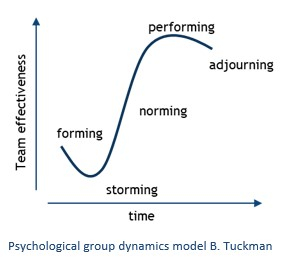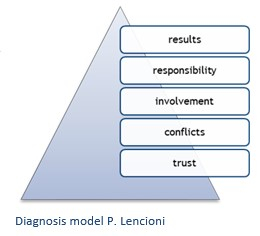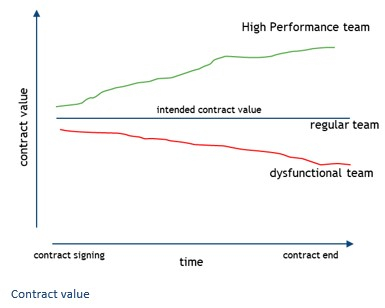Shaping high-performance teams for international projects
For the successful realization of an international project, it is of utmost importance to have a High-Performance Team (HPT). However, building and maintaining such a team is always a challenge.
In this case study, I will guide you through the what-and-how of HPTs based on experience gained from an international project where I am in the team leader’s role. It will provide insight in how to build an HPT. And how to ensure that it functions optimally.
Context
This case study is based on a project where Stork AMT realizes an Asset Performance Management (APM) system at an international client. The implementation is applied simultaneously within a petrochemical plant (brownfield) and a refinery (greenfield). Thus, one way of implementation, two different cases.
Within the project scope, four contract parties have been placed under the responsibility of Stork Asset Management Technology. The duration of the project is 3½ years and at the moment of writing this article, there is almost 1 year left. The project team consists of 16 colleagues, with a total of 7 different nationalities and associated cultures. The project activities are partly performed at the customer location – outside Europe – and partly from the relevant Stork location, such as Utrecht (The Netherlands) and Houston (USA).
As stated before, I – the author – am in the role of project team leader.
High-performance team
In a regular team, there is a lasting collegial relationship in which the management continuously focuses on coordinating and connecting content and personal relationships. Many teams assume that clear work agreements have been made, but that is often not the case. The performance of a regular team usually meets the objectives, but is rarely optimal. This costs a lot of energy, which has a negative effect on the performance, even if it is still in accordance with the contract value.
Definition
There are several definitions of an HPT from scientific studies. Scientist Kur, E. has defined an HPT as quoted below, which is frequently cited in studies and elaborated in case studies.
“HPTs consistently satisfy the needs of customers, employees, investors and others in its area of influence’’ and as a result “these teams frequently outperform other teams that produce similar products and services under similar conditions and constraints’’.“HPTs are purposeful, social, human-oriented, technical and systematical’’.
By Kur, E. (1996)
In this case study, we define an HPT as follows. An HPT is a unit with team spirit, loyalty and high morale. There is effective cooperation for the intended objectives. The HPT has a temporary character with clear objectives and absolute deadlines. And finally, there is constant pressure on the team.
Building and development
 Before I discuss the content, first an explanation about Tuckman’s model in the chart: it describes the five stages that a group goes through to achieve good cooperation. A crisis characterizes the transition between each stage, and in fact, the subsequent stage is intended to resolve the crisis. Time is shown on the x-axis and Team Effectiveness on the y-axis.
Before I discuss the content, first an explanation about Tuckman’s model in the chart: it describes the five stages that a group goes through to achieve good cooperation. A crisis characterizes the transition between each stage, and in fact, the subsequent stage is intended to resolve the crisis. Time is shown on the x-axis and Team Effectiveness on the y-axis.
The first stage is the forming stage in which the group is composed and gets to know each other better. The next stage is also called the conflict stage. Emotions increase and disagreements can become personal. This has a negative effect on the effectiveness of the group.
Subsequently, the team – now no longer a group – enters the Performing stage via the norming stage with a substantial increase in effectiveness. As mentioned in the definition of an HPT, it has a temporary character and will eventually be dissolved in the adjourning stage.
In the following paragraphs, I describe how this team – of which I am a part – went through and experienced these stages.
Forming
In this first stage, the group is composed and everyone is enthusiastic and looking for their place in the group. The selection of the group members is based on the required competencies and behaviours for this international project. Stork’s Knowledge Online platform has simplified this process; by asking the relevant subject-matter experts which Stork/Fluor colleague – based anywhere in the world – can best join this group and at what time with what specific expertise.
The project and its objectives are explained in more detail, but the initiatives are still marginal. It is important to create trust. Trust in the project plan and each other’s knowledge and skills to realize this. But the opposite happened: the group approached the project as a routine assignment and avoided conflict. After a while, the tension is palpable, but is not spoken to each other or only to the team leader. As a result, uncertainty creeps into the team.
Storming
 To break through this tension, I consciously created a conflict within the group during this stage. I used Lencioni’s model to collectively identify the frustrations of the group that sabotaged the collaboration. At first, many group members shy away from the confrontation, even though we discussed the conflict respectfully.
To break through this tension, I consciously created a conflict within the group during this stage. I used Lencioni’s model to collectively identify the frustrations of the group that sabotaged the collaboration. At first, many group members shy away from the confrontation, even though we discussed the conflict respectfully.
The somewhat forced breakthrough in this was an Intercultural Training provided by the Royal Tropical Institute in Amsterdam (The Netherlands). This training has helped the group to create and deal with positive conflicts with and within different cultures. After all, the first two stages proved that creating and dealing with positive conflicts is not self-evident.
You may think to yourself: a positive conflict? Can there be such a thing? Yes, there is, and it is essential for an HPT to create an environment that embraces positive conflict. However, the key is to manage conflicts properly so that the results are creative solutions to problems that ultimately increase the group’s effectiveness after a relapse.
Norming
The group has gone through the previous stages – with a continuous and unpredictable alternation of the opposing emotions of anger and enthusiasm – and has now transformed into a team. It has become far more than a group!
Within the team, the expectations of and towards each other are clearly defined. The project scope is clearly defined in methodologies, systems and processes with associated indicators. An important indicator that has been added is the level of Team Energy.
This is also the stage where the customer group joins the Stork team. From that moment on, the first two stages have been completed several times to arrive at one customer-Stork team finally. However, this has now been achieved together with the customer group of the refinery and petrochemical plant and the Stork team. As a result, the existing expectations have been further supplemented so that a one way of working method and corresponding behaviour from the customer-Stork team has been formulated. Of course, without restricting creativity.
Later on, we will see that the Tuckman model stages have been passed through many times for different reasons or backgrounds.
Performing
What is happening to the team now? A right combination of cooperation, mutual dependence and self-reliance has emerged. All this with minimal control from the team leader, whereby the objectives – on an individual and team basis – are successfully achieved, for both the customer and Stork. For me, this team approaches the definition of an HPT quite nicely: effective collaboration, loyalty & spirit.
The team exudes calmness and confidence. The core of this is the right balance between Social and Business on a personal and professional level, which is continuously monitored in the Team Energy barometer. This barometer can be a guideline to unconsciously, but competently, return to one of the previous stages. Later I will quote a Game Changer in which this has taken place.

Adjourning
The inevitable; the team is dissolved. This stage is constantly present because, after successful delivery of a (partial) deliverable within the project, the colleague in charge already says goodbye because “his job is done”. Consider this as a farewell! After all, it is not about a passer-by that joins a group and then leaves again. It is about an essential part of a close team that is cut away. So, it hurts when someone leaves, no matter how weird it sounds! It is about saying goodbye to someone you have opened yourself to with your emotions, positive conflicts and self-reflection.
From a business standpoint, it is essential that knowledge and skills are secured internally at Stork as a Best Practice. Perhaps the foundation is sharpened/deepened based on newly demonstrably gained insights from the customer, Stork or the industry. This “closing the Loop” is facilitated by Stork’s Knowledge Online platform.
In addition, this team presented several webinars, seminars, lectures and white papers. With pride. Proud to experience this and share it with others. So if someone leaves the team … “It’s never a goodbye, it’s a see you later”.
Leadership
For me, as a team leader, it was important to consciously go through the first three stages with the team in a very short time. There is no precise moment when you move from one stage to another or when you step back. What I did consciously in these first three stages is guiding, delegating and facilitating in creating conflicts, aligning and connecting to grow from there in mutual trust to realize the team objectives.
Leary’s interpersonal circle model has promoted openness and honesty by discussing this together. It was a learning moment for me not to force this, but to give the process and each individual time to decide for themselves how far to go in this at what moment. Release this from structure, and you should be fine! However, it does mean that there is still constant pressure on the team to achieve the objectives. Especially in the first three stages, it is not infinite and without obligation. In addition, it is good to know your leadership styles and be able to recognize the moment to switch within the three levels of leadership. Level one focuses on I, level two on 'you' versus 'we' and the last on the 'system'. There are no guidelines for this; as a team leader, you know where your strengths lie: you are open to others, the team and the system from your awareness.
 Before looking at the Contract Value versus Team Development, let’s explain the chart first. The x-axis shows the Time and the y-axis the Contract Value. The horizontal line in the picture represents the agreed value. The line above represents the value for an HPT, and below it for a non-functioning team.
Before looking at the Contract Value versus Team Development, let’s explain the chart first. The x-axis shows the Time and the y-axis the Contract Value. The horizontal line in the picture represents the agreed value. The line above represents the value for an HPT, and below it for a non-functioning team.
Within this team, the objectives exceed the agreed contract value. Which is jointly demonstrated from the contract performance indicators, customer business operation indicators and the jointly drawn up business case from this project. Stork is no longer perceived as a passer-by for an implementation project, but as a partner for building the future “Asset Performance Management Way of Working” generation within the customer.
It is often difficult to demonstrate this concretely. Still, if the team does not function and whether you lose a customer or have to perform unforeseen and unpaid work, it is immediately noticeable financially, for both the customer and Stork.
A vital team indicator for everyone is enjoying their work; experience the fun. And there is fun for sure! It pleases me to see how everyone with different backgrounds and cultures interacts with each other on location, both in business and in their leisure time. Everyone in their own way. That’s what you do it for! The training of the Tropical Institute has undoubtedly contributed to this success.
Game Changer
The work environment changed from one day to the next with COVID-19! Contractors were no longer allowed to be physically present at the customer location. This was a COVID-19 customer precaution. In addition, it was strongly advised by, among others, the Dutch government to leave the country urgently due to the emerging COVID-19 pandemic. Four days later, almost all air traffic stopped.
A pandemic was not foreseen in the 3-monthly risk assessment with the customer. But how has the project been continued successfully? Both business-wise and mentally. Of course … Safety First.
First, there was the team’s peace of mind to accept this and switch directly to the Forming-Storming-Norming stage within one meeting. Within 1½ days, there was an emergency plan with multiple If-Then-Else scenarios. Because now we wanted to be prepared for the worst scenarios.
What happened in these 1½ days?
First, we started to form a mind map of the impact for current and upcoming deliverables and mutual relationships. This was done from the existing project plan with a horizon of 6 months and a horizon until the project’s end. The quantitative judgment on this is further elaborated in scenarios in which the deliverables’ quality is a critical weighing factor. The final decision on what will take place within each deliverable is laid down in a Contingency Plan, which has become an integral part of the project plan. This Contingency Plan forms the basis of a weekly meeting with the customer about the progress and results of the past week and the upcoming week’s adjustment in detail and subsequent weeks in outline. The content and resource scheduling of the Contingency Plan is formed from the relevant customer-Stork AMT colleague who is responsible for the relevant APM pillar under which the deliverable belongs.

I am proud that to date, we have not had any idle time on the project and that we have delivered the deliverables on schedule with the expected quality. Perhaps even better, even though expectations were already high before the start of the pandemic. The customer expressed this satisfaction to Stork. Working completely remotely now is a success because the basis has been created in a way that this was possible. The work was already partly performed remotely with proven communication systems and structures. The project organization was formed in the storming stage by being really open to each other and learning to speak out loud. Not always nice, but always approached from positive conflict management.
The threat is now the upcoming APM Extensive Training module. The creativity will probably be found in Remote Training. Although the already prepared training material must be made suitable for this, of course provided with the right communication systems and didactic skills. This team will undoubtedly succeed in this. But as said, after everyone’s safety and well-being, quality always comes first, and one scenario is that a deliverable will be postponed.
Not yet mentioned but essential, during this COVID-19 period the mental health of both the customer and the Stork team members receives extra attention in the ongoing Social-Business meetings.
Resume
While the introduction and implementation of an HPT can be challenging, the benefits are far-reaching, not only for mutual profit and productivity, but also for team morale and employee retention. However, the organization must support the removal of structural barriers, and the HPT must become accustomed to non-hierarchical management, positive conflicts and always seeking the next challenge. Even if this next challenge is a real game changer, approach it as a unique opportunity!
It is important to realize that being part of an HPT should be a personal and conscious choice. The question you have to ask yourself in advance is: does this suit me or not?
I am proud to be part of this team. A HPT of which I dare say that it has almost come close to “optimal functioning”.
Reflection
The model of Tuckman, B. has been criticized for its scientific basis, and therefore it was applied pragmatically in this case study as a ‘team analysis-research-development tool’ to arrive at an optimally performing team. A High-Performance Team.
Reference
KIT Royal Tropical Institute, Amsterdam.
Kur, E. (1996), “The faces model of high performing team development’’, Leadership & Organizational Development Journal, Vol. 17 No. 1.
Leary, T. (1957), “Interpersonal diagnosis of personality; a functional theory and methodology for personality evaluation”, New York: Ronald Press.
Lencioni, P. (2002), “The five dysfunctions of a team: A leadership fable (1st ed.)”, San Francisco: Jossey-Bass.
Lencioni, P. (2005), “Overcoming the Five Dysfunctions of a Team”, Jossey-Bass.
Stork Knowledge Online; SME & Knowledge Community Definitions, Guidelines and Expectations.
Tuckman, B. and Jensen, M. (1977), “Stages of small group development revisited’’, Group and Organisational Studies, Vol. 2 No. 4, pp. 419-527.